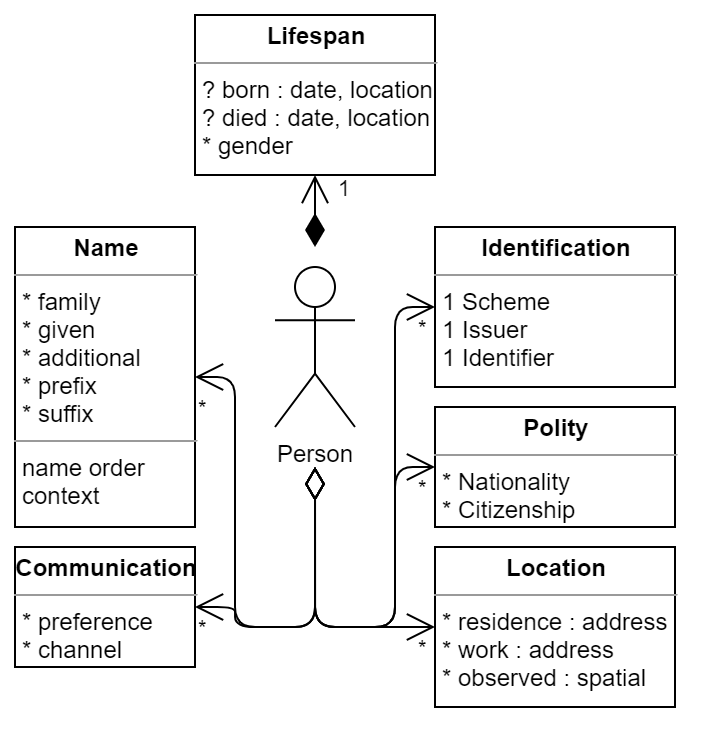Person
There are many ways to identify and represent a person. Here we present aspects of each, in the hopes of developing interoperable standards.
Identification
There are many ways to identify a person, from names to barcodes.
It should be remembered that a person may have many identifiers,
some of which may not uniquely identify them.
We recommend the the identification scheme is recorded with the identifier.
Identification documents
In particular the identification of the issuer of the documentation should be recorded. Note that a person may legitimately have multiple identification of the same type from the same issuer.
Life span
Everyone is born. Everyone dies. We may not know where or when we die, when or where we were born. Some of us have only a vague idea of birthday, not even knowing the year. In those cases, people should be able to elect a date to use, even without paperwork.
Dates of birth and death may be unknown, unrecorded, or may have a degree of uncertainty. Systems should allow these to be optional, and to allow ambiguity.
Similarly, place of birth and death may be unknown, unrecorded or have a degree of uncertainty.
Gender
Most people are born male and female and stay that way throughout their lives. Some people may change gender physically and/or legally (transgender). Still there are others, intersex or otherwise, that may be considered as another gender altogether, neither male nor female.
Systems should permit optional recording of gender, allowing at least male, female and other, and premitting these to change over the course of time.
Names
A person born with one name, may acquire or choose to have other names over the course of their life. Not just a change of name through marriage, but also through deed pool, other legal instruments, and even just by common use. Further each of the names may have multiple translations or transliterations into other scripts and langauges.
Systems should permit a person to have multiple names, and may also record the relationships between the names. eg. My Greek name
Ιάσον is transliterated into the Latin alphabet as Iason, but in English it is Jason.
The position and purpose of names differ amongst the world’s culture.
In some cultures, a surname may indicate whether a female belongs to her father, or to her husband upon marriage. In others a family name may never change. Sometimes it comprises a matronym and a patronym.
Sometimes, which name comes first depends on the context.
It is recommended that either:
– names be stored whole, and the parts marked up if required;
– name parts be stored, with a sequence for a context.
The vcard ontology is fairly straightforward requiring at least one name, and permitting parts of family, given, additional, prefix and suffix.
Location
It may be useful to know where a person is, lives or works.
Systems may record this information as a physical location using spatial coordinates, as descriptions, or as structured addresses.
There are many styles of addresses, some of which may include convenience codes, such as zip codes or postal codes.
Communication
Communication with people can occur along many channels. They may permit or prefer you to use some of their communication channels over others, and at various times and contexts.
Postal Address may refer to a physical location. Note that a postal address can include post office boxes, which can be physical redirections of post to a real location.
Telecommunications numbers should be recorded as an E.164 format number. It should record which services are permitted when.
eg. It could be a fixed phone by day, and fax by night. Some telcos enable landlines to receive SMS as voicemail.
Electronically, there are a many messaging applications. Internet email is just one type of messaging service.
Polity
From wikipedia:
A polity is an identifiable political entity … such as a state, an empire, an international organization, a political organization.
Citizenship is a legal status in a political institution such as a city or a state.
Nationality, on the other hand, denotes where an individual has been born, or holds citizenship with a state.
It is possible for a person to hold multiple nationalities and citizenships at the same time. It is also possible to have just one, or none at all. Where a person is known to be stateless, this should be distinguished from not knowing whether a person has a state.
It should be noted that some people are not aware of their nationality, as it may be inherited.
Diagram
This diagram shows the essence of personal information for a person.
Although a person has just one lifespan, we may be uncertain about the time and place of their birth and death, and may change genders.
They may have many names used in different ways.
They may have a variety of preferences on how to communicate with them.
They may have several associated locations for home, and work.
They may have several nationalities and citizenships.
Many identification may be issued to them.
